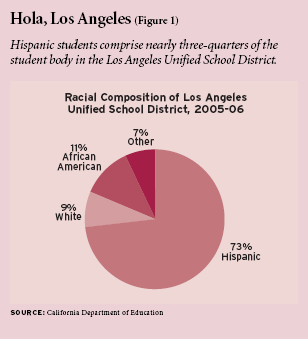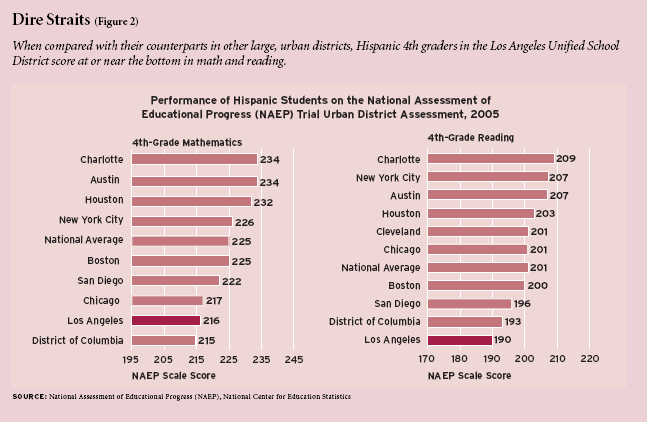
From a distance, it probably looks as if Los Angeles mayor Antonio Villaraigosa is about to take control of his city’s schools, giving him the kind of clout over education that the mayors of New York, Chicago, and Boston have enjoyed for years. The California legislature, with the enthusiastic support of Governor Arnold Schwarzenegger, passed a bill last summer that seemed to grant the dynamic mayor significant new powers over the sprawling Los Angeles Unified School District (LAUSD), the nation’s second-largest, with 873 schools spread across 700 square miles and 27 cities. And Villaraigosa has told his constituents that he wants to be held accountable for the schools’ performance.
“The buck needs to stop at the top,” Villaraigosa said in a speech last year. “Fragmentation is failing our kids. Voters need to be able to hire and fire one person accountable to parents, teachers, and taxpayers—a leader who is ultimately responsible for system-wide performance.”
But Villaraigosa, for better or worse, will not be that person. Because the closer you get to Los Angeles, the murkier this picture becomes. If a camel is a horse designed by committee, the mayor’s plan for reforming L.A.’s schools is more like a horse designed in the dark. Indeed, the plan, nailed down in a late-night negotiating session in a Sacramento hotel, was fashioned to appease powerful interest groups—mainly the teachers union—that opposed the mayor’s first proposal to overhaul the district. Rather than centralize accountability in one person, it fragments power further. Rather than ending years of divisive finger-pointing, the plan’s most likely result is probably more finger-pointing than ever. Chances are, parents, community leaders, and educators will be left years from now with an even greater sense of uncertainty about who really runs the district and to whom they should turn, or assign blame, when things go wrong.
Yet all of this could happen and there is still a decent chance that the plan will improve opportunities for at least a share of Los Angeles children. And if that happens, Villaraigosa might emerge as a political winner, with his leadership on the issue having paved a path to the governor’s office or the U.S. Senate by 2010. To understand why, you have to look at the details of the plan that the legislature approved, and consider how it will likely play out in the years ahead.
The Devil Is in the Details
 Los Angeles Unified, with its nearly 730,000 students, in many ways reflects the sprawl that has come to define the region, as well as its emerging demographics. Nearly three-quarters of the students are Latino, while fewer than one in ten are non-Hispanic whites (see Figure 1). Almost 300,000 students, or 40 percent of the enrollment, are classified as English-language learners, which means they have not yet been certified as fluent in the language.
Los Angeles Unified, with its nearly 730,000 students, in many ways reflects the sprawl that has come to define the region, as well as its emerging demographics. Nearly three-quarters of the students are Latino, while fewer than one in ten are non-Hispanic whites (see Figure 1). Almost 300,000 students, or 40 percent of the enrollment, are classified as English-language learners, which means they have not yet been certified as fluent in the language.
By most measures of academic performance, the district’s students are struggling (see Figure 2). Less than one-third are reading and writing at grade level, and barely more than one-third are performing at grade level in math, according to results on California’s standardized tests. A freshman entering the district today has less than a 50 percent chance of graduating four years from now, according to one study, and the odds are even worse for Latinos.
Roy Romer, the former Colorado governor who retired last year after six years as superintendent of L.A. Unified, tried in vain before leaving his job to convince the mayor, state legislators, and the governor that the district was not failing. His own aggressive reform program of centralizing curriculum decisions, adhering closely to state standards and providing intensive care to the lowest-performing schools, Romer said, was beginning to pay off. He cited progress on the state’s Academic Performance Index, which he said showed the average LAUSD school improving at a faster rate than the rest of the state’s schools. And he produced independent research that showed L.A. students outperforming those in most of the state’s other large districts when poverty and language acquisition numbers were taken into account.
“We want to be much more successful,” Romer said in a speech to educators last year. “But to single us out in legislation and say, ‘We’re uniquely a failing district and, therefore, we need to legislate,’ is really an excuse to hide political motive.”

But Romer’s pleas fell on deaf ears. Relying on data that showed L.A.’s progress would still leave about 40 percent of students performing below grade level by 2014, Villaraigosa pushed at first for complete control over the district. That proposal met stiff resistance not only from Romer and the independently elected school board, but also from the leaders of the district’s other cities and from the teachers union, which has real clout in Sacramento. The result was a hybrid plan that satisfied no one, but which the mayor embraced as his best opportunity to create change.
Under the plan, the mayor is to get more or less direct control over three low-performing high schools and the elementary and middle schools that feed into them. He was also, in theory, supposed to have a role in the selection of the district’s superintendent, through a council of mayors made up of the elected leaders of the district’s 27 cities and members of the county Board of Supervisors. That council, which Villaraigosa will dominate by virtue of a voting system weighted by each city’s population, is also supposed to review the district’s annual budget, though final control would still rest with the school board.
The new law also changed the balance of power between the board and the superintendent. Lawmakers, at the mayor’s urging, sought to reduce the clout of the board and make the superintendent more of a true executive. So the law prohibits board members from hiring personal aides, leaving them with only a pool of staff answering to the full board, and it gives the superintendent full control over most personnel decisions and contracts, other than the collective bargaining contracts with district employees. It also gives the superintendent control over the individual line items in the budget and limits the board’s ability to change those decisions.
A provision in the law further diffuses the lines of authority by requiring the school board to consult with parents and teachers on the district’s curriculum and mandating that classroom teachers elected by their peers be in the majority on curriculum and textbook selection committees. Greater power over the curriculum and the choice of texts has been a long-standing goal of the California teachers unions, which have sought, unsuccessfully, to pass state legislation that would have placed the issue squarely into collective bargaining negotiations. They will now have that influence in Los Angeles Unified.
The end result is that, instead of a school board accountable to the voters and a superintendent accountable to the school board, the district now has multiple power centers. The board will still be elected and will choose the superintendent, but the mayor is supposed to have veto power over that decision, and the superintendent is supposed to have more power to act independently of the elected board. The board is still responsible for passing the budget and for setting the district’s priorities, but Villaraigosa, acting with his fellow mayors, will review the overall budget. The superintendent will have more control over how it is spent. The teachers, meanwhile, will have power over curriculum decisions that used to be left to the board.
A Rocky Start
The approach was so muddled that one of Villaraigosa’s most important allies in the reform battle, billionaire real estate developer and philanthropist Eli Broad, abandoned the effort. Broad, whose nonprofit foundation has pushed for mayoral control in urban districts around the nation, criticized the Los Angeles plan because it would force the mayor to share power with the school board and the teachers union. He urged that the superintendent, under the direction of the mayor, be given control over the budget and all hiring and firing in the district. The compromise Villaraigosa fashioned, Broad told him in a letter last summer, would be worse than the status quo. “If significant changes are not made,” Broad said, “we may be better off having the bill fail.”
But few changes were made after that, and already some of the problems about which Broad warned have begun to surface. The first was in the selection of a superintendent to succeed the retiring Romer. Romer and the school board timed that decision to happen before the reform law took effect, and the board, defying the mayor, chose a new district leader without his participation, while he was out of the country on a trade mission. Villaraigosa and the new superintendent, retired Navy admiral David Brewer, have since established a civil relationship, but Brewer was clearly not his first choice, and the selection process only created more bad blood between the mayor and the school board.
The mayor, meanwhile, has begun to raise private funds to support the schools he will eventually take over. He has collected pledges of $1 million from Verizon and another $1 million from the Bill & Melinda Gates Foundation and the William and Flora Hewlett Foundation. But as those millions began to add up, school district officials complained that the mayor’s schools would have favored status over those left behind in the main district.
Kevin Reed, the district’s general counsel, called the donations a “shift away from the partnership ideal, where the money goes to the kids who need it most.” The mayor’s schools, Reed told the Los Angeles Times, will be “haves,” while district schools will be the “have-nots.”
The schools that Villaraigosa may eventually take over are likely to be showered not only with new money but with attention, and they will almost certainly benefit from the mayor’s need to show immediate progress to validate his approach to the issue. To run the schools, he has recruited a solid team of advisers, beginning with Ramon Cortines, a former LAUSD superintendent who has also been head of the New York City and San Francisco schools. Also onboard is Marshall Tuck, former president and chief operating officer of Green Dot Public Schools, which has built a chain of charter schools in the district while organizing a parents’ “union” and constantly pushing district officials to take bolder steps to improve the performance of children from poor families. Villaraigosa also hired a former Long Beach Unified School District assistant superintendent, a veteran teacher, and the former president of the Riordan Foundation.
The mayor’s team is to choose three high schools from among the district’s lowest-performing, and from different geographic regions, for him to run. Each cluster will include middle and elementary schools as well, giving Villaraigosa control over about 30 schools in all.
Villaraigosa’s Master Plan
Even before identifying the schools he would run, Villaraigosa sketched out the approach he would take to reform them and, he hopes, to overhaul the rest of the district while he is at it. The program ranges from requiring school uniforms and community service to asking parents to sign compacts committing them to participating in their children’s education. He wants to cut administrative bloat and plow the money into the classroom, raising teacher salaries while giving the faculty more responsibility over instructional materials, peer review, and other matters.
The mayor also wants to reduce the size of the schools—or schools within schools—to no more than 500 students, and he wants to create “community partnerships” that would draw the private sector and nonprofit groups into the job of educating the city’s kids. He also pledged to lengthen the school year, improve safety on school campuses, and reinvent vocational education. Finally, once all those changes are implemented, he said, he might be willing to ask taxpayers to pay more to support the schools.
But Villaraigosa will not have free rein, even over the schools that are nominally in his control. Under his compromise with the teachers union, the districtwide collective bargaining agreement will still apply, limiting his flexibility. The membership of the United Teachers Los Angeles, the district’s teachers union, voted to oppose the plan even after the union’s leaders endorsed it, suggesting that quick changes to the rules governing the mayor’s schools will be unlikely. He will also have to negotiate with district headquarters over provision of janitorial, cafeteria, transportation, and other support services. Unlike charter schools, which in California have considerable freedom from state and local laws and regulations, Villaraigosa’s schools will have their hands tied on many issues.
Still, it’s not hard to imagine him making some improvements. The schools he takes over will be among the worst-performing in the district, so they will have nowhere to go but up. The publicity surrounding his takeover is likely to improve morale, attract energetic teachers, and engage parents in the project. The extra money he raises from the private sector will help to improve school facilities, buy better equipment, and perhaps even raise teacher salaries.
But even if the handful of schools that fall within the mayor’s orbit improve, the question is what will happen to the other 800-some schools in the district. The mayor under the new law has little to say about their fate, and even less since he was cut out of the selection of the superintendent. He and his council of mayors will find it hard to influence the budget, the curriculum, or how the district spends nearly $20 billion in new construction money that has been raised through recent bond measures. The broader district will probably continue along its recent path. And even if it is slowly improving, as former Superintendent Romer contends, that improvement will be difficult to discern amid a sea of conflicting statistical measurements.
It is not hard to imagine, then, a scenario under which Villaraigosa a few years from now will cite some dramatic if narrow improvements in the test scores of the students in the schools under his control, while ducking responsibility for the problems that remain in the broader district. Having asked for full control over the entire district, he might say that if he had been given such powers, those schools would be getting better, too. While that might not be a realistic argument, given the nature of the reform plan, it will be difficult to refute.
Daniel Weintraub is the public affairs columnist for the editorial pages of the Sacramento Bee. He has covered California politics and public policy for more than 20 years.


